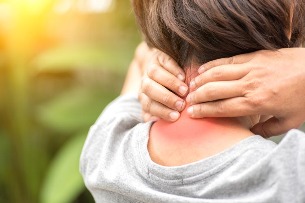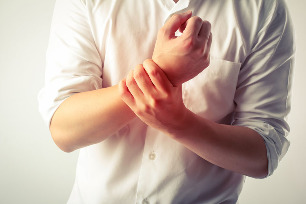Osteochondrosis – a disease, which is one of the most popular in the world. Most people after the age of 35 years have osteochondrosis of the cervical spine in one form or another. Recently is observed a trend to increase the number of suffering from a severe form of the disease and to rejuvenate the the disease, reduce its lower age limit. This is due to the fact that a growing number of people around the world engaged in sedentary work and see a sedentary way of life. Meanwhile, the disease is enough dangerous, and each person should know what it is – osteochondrosis, how it manifests itself and how to treat, be able to recognize the symptoms and in time to start treatment.

Causes of cervical degenerative disc disease
Osteochondrosis is one of the few diseases that are typical only for humans. In other animals the disease occurs. The reason it is such a distinctive feature of man, as bipedalism. The vertical arrangement of the vertebral column is seeing, to the fact that the vertebra are putting pressure on yourself, and musculoskeletal cartilage tissue of the spine is gradually reduced and deformed. The spine of a man begins with the neck. Just in this department of seven vertebrae – the first to the seventh. The vertebrae are separated from each other by intervertebral discs. The cervical spine is particularly vulnerable part of him that is connected, first of all, with increased mobility of the vertebrae in this area. In the cervical disease is mainly reflected on the disks, which are the weak point in the structure of the spine. The Prevalence of cervical degenerative disc disease also contribute such factors as the small size of the vertebrae and the relative weakness of the neck muscles. Also on the development of cervical degenerative disc disease has a great influence lack of blood supply to the cartilage. So the development of the disease is a complex and time-consuming process, and it has for one simple reason. Even if a link is created between a sedentary person and in his cervical degenerative disc disease, however, the disease often occurs in based people, especially athletes, because of increased load on the cervical spine when lifting weights. In older people, as usual, the degradation of vertebrate structures – this is an inevitable process associated with aging of the organism and its weakening of the protective forces. However, most often occurs in pathological type of cervical degenerative disc disease, in which the main role is played by the external helena internal negative factors.
Factors contributing to the development of degenerative disc disease of the neck:
- Violation possession of your body
- Curvature of the spine
- A back injury
- Overweight
- Heavy physical work
- Sedentary work
- A sedentary way of life
- Violation of the metabolic processes
- Frequent hypothermia
- Uncomfortable posture of your body during sleep
- Stress, overwork
- Hereditary factors
- Infectious disease
- The individual elements of the construction of your body, for example, is too long helena too short neck
The degree of development of cervical degenerative disc disease
The disease has four stages. It is not always easy to determine the stage of the disease on the analysis of the symptoms because sometimes it is the degree of the degradation of the pain of the cartilage may not correspond to the symptoms observable in the patient.

The first degree
Begin the destructive processes in the musculoskeletal cartilage of the vertebrae. Typically, at this stage, degenerative disc disease of the cervical symptoms are poorly expressed. Sick, helena at all do not perceive, helena are not associated with diseases of the spine, and attribute this to stress and fatigue.
The second stage
Starting to reduce the height of the disc, on its surface appear cracks. Symptoms of cervical degenerative disc disease at this stage are manifested in the constant headaches, weakness, numbness of the individual areas of the face.
The third degree
Are formed by herniated discs, damaged neck vessels and muscles. The patient experiences dizziness, pain in the occipital part of the head.
Fourth grade
Appear osteophytes – outgrowths of bone tissue that protects the vertebrae from the load, which sees to a violation of the nerves. It sees to the stiffness of the movements and damage to adjacent joints.
Cervical osteochondrosis: symptoms
The main symptoms of degenerative disc disease of the cervical spine:
- Pain in the neck and shoulders
- Weakness of the muscles
- Increased sweating
- Numbness in the hands
- Violation of coordination
- Vertigo
- The deterioration of vision and hearing
- Increase in blood pressure
- Headaches
These typical for degenerative disc disease of the cervical spine symptoms can be present in all stages of the disease. In most cases there has been only a few symptoms from the list, and the rest can be a Person, for the first time faced with similar symptoms of the disease, not always suspected in yourself cervical osteochondrosis. Therefore, it can refer to a variety of doctors – therapists, cardiologists, neurologists, physicians. And the correct diagnosis is consequently, may be supplied with a considerable delay.

Syndromes
When cervical osteochondrosis occurs in several syndromes, it is typical for states that have complex characteristics. Manifest themselves depending on which nerves and arteries affected due to illness:
- syndrome vertebral artery
- cardiac syndrome
- hypertensive syndrome
- root syndrome
- syndrome neck, migraines
Syndrome vertebral artery – one of the most unpleasant and dangerous complications in cervical osteochondrosis. This is due to the fact that it reduces blood flow in the artery, passing along the spine, and the power of the brain. Syndrome manifested as symptoms such as systemic helena regular dizziness, weakening of hearing and vision. In some cases, can become fainting. It is often observed a kind of syndrome, surrounding that in the normal state of the blood flow in the arteries normal, however when turning the head in one direction helena else can drop dramatically. Cardiac syndrome develops when squeezing the roots of the nerves passing through the innervation of the diaphragm helena chest muscles. As a result, the patient may be observed of pain, reminiscent of the cardialgia, even though the immediate effect on the heart, when it's happening. However, for the syndrome can be characterized by like phenomena, such as tachycardia, hypotension and arrhythmia. Hypertension syndrome are also among the most dangerous complications. Unlike the syndrome of the vertebral artery, is summoned compression is not the arteries and veins, which hinders the outflow of blood from the head. Syndrome sees an increase in intracranial pressure, which can manifest in symptoms such as nausea, vomiting, headaches. Syndrome neck, migraine has little to do according to their etiology with the classic migraine. It manifests itself in the most intense pain in the occipital part of the head. The pains are paroxysmal in nature, lasting up to ten hours and are accompanied by vomiting. Root syndrome – the most common syndrome in osteochondrosis of the cervical. Called the compression of the individual roots of the nerves in the cervical vertebrae. It can be expressed in pain in the area of neck, nape, shoulder blades, the shoulders, the numbness and weakening of the tone of the individual sites of the hand (up to the impossibility to perform some sort of manipulation) and the neck. Very often one can observe several syndromes helena individual symptoms characteristic for different syndromes. As seen in osteochondrosis of the cervical spine manifestations of the disease multifaceted and far not always it is the patient able to correctly recognize according to her the cause of their occurrence. If you experience similar symptoms, then this is the reason for the appeal to doctors.

Diagnosis
For installation of the diagnosis it is recommended to consult with a therapist. Will give direction to professionals – podiatrist, spine, neurologist. For the diagnosis applies to the following types of research:
- Radiography
- Computed tomography
- Magnetic resonance imaging
- Ultrasound examination of the vessels of the neck
X-ray allows you to specify the offset of the vertebrae, the availability of growths – osteophytes and salt deposits, sealing discs. Computed tomography is to create a series of x-ray images, provides a spatial idea of the registration, in this case – of the cervical spine. It allows you to scroll to the degree of disorder of the process – character of squeezing the nerves, the structure of the osteophytes, the height of the disks, and so on Magnetic resonance tomography, which is based on the physical meaning of nuclear magnetic resonance, provides a more detailed structural image of the spine. ULTRASOUND examination of the vessels of the neck helps to identify the blood flow changes in the vertebral blood vessels of the neck, caused by the disease.
Treatment of cervical degenerative disc disease at home
How to treat osteochondrosis of the cervical at home and treated, zdf it at all? For the struggle with the disease, medicine has developed many techniques. Some of the ways treatment can be applied at home. But this process is lengthy and a complete cure is unlikely, especially in old age. However, to slow down and stop the destructive processes in the spine is possible in any stage of the disease. In the early stages of the disease the techniques are usually conservative. Treatment of cervical degenerative disc disease is used several ways:
- Drugs
- Therapeutic physical education
- Physiotherapy
- Massage
- Special means for fixation of the spine
If the disease has passed into the last stage, and going on a serious destruction of the pain of the cartilage models of the spine, then for the treatment of degenerative disc disease of the cervical spine, may request and operative intervention.
Products
Applies to the following types of drugs:
- Chondroprotectors
- Vitamins
- Analgesics
- Anti-inflammatories
- Antispasmodics

In acute pain syndrome associated with osteochondrosis, the priority is its removal. In general oral medications, such as Analgin helena Baralgin, however in their inefficiency, in severe cases is used novocaine blockade. When muscle spasms apply antispasmodics. The greatest efficiency in osteochondrosis of the shows created against this disease cure, although it is possible, and the use of other relaxation of the muscles. As an anti-inflammatory and drugs resources you can use ointments containing non-steroidal drugs. In the presence of syndromes associated with impaired blood circulation and blood supply to the brain – hypertensive and syndrome of the vertebral artery, take drugs, eliminating the side effects of these syndromes – the means to reduce the pressure and the substances used means.
Therapeutic physical education
Therapeutic physical training – the simplest and affordable method of treatment of cervical degenerative disc disease and, at the same time sufficiently effective. Treatment exercises it is possible to perform well in home conditions. In osteochondrosis of the intensity does not play a decisive role, what is required is only their regularity. In the first place, the exercise is designed to strengthen the muscles of the neck, which fill the insufficient functionality of the spine and help him to maintain the weakened vertebrae. For strengthening the muscles of the neck the recommended daily activities. They can be both quite simple, it consists of speed and předklonů head in different directions, so even more complex, including tracking help the neck muscles from the side of the hand. It is possible to perform well at home, and at work. For example, if you work in a seated position, it is useful to do such exercises after an hour of sitting at the table helen the monitor. However, their implementation is possible only outside the period of exacerbation of the disease, and if there is no pain syndrome. In the opposite case, they are able to only worsen the condition. Not less effectively and strengthen the muscles of the shoulder girdle, for example, with the help of regular exercise with light dumbbells. However, lifting weights (kettlebells, dumbbells) is contraindicated. It is also helpful to regular swimming lessons, the unloading of the spine.
Physiotherapy
Physiotherapy – a method of treatment that uses the effects on the body some of the physical fields and radiation. A positive property of physical therapy is that it has the minimum number of contraindications. For the treatment of degenerative disc disease applies the following methods of physiotherapy:
- Ultrasonic exposure
- Laser therapy.
- The influence of the magnetic field
- The effects of electric current (electrophoresis)
The magnetic field has a positive effect on the damaged tissue of the organism and has anti-inflammatory and pain medication effect. Ultrasound improves the metabolic processes in the tissues, relieves swelling. The same can be said about laser therapy. Electrophoresis is most commonly used in combination with medicinal products, whereas use of electric current accelerates their absorption in the body.

Massage
Massage reduces increased muscle tone, which causes cramps and reduces the flow of lymphatic circulation, which causes swelling. The procedure helps to improve blood circulation in the affected area, which stops the process of destruction of the intervertebral disc.
Other methods of treatment
What to do when cervical osteochondrosis, if the classical methods of treatment at home do not help? For reducing the load on the cervical department uses a special device – collar Trench, which records the neck in a constant normal position. It is recommended to wear during exacerbations of pain in the syndrome of helena in a long-term job sitting down. For addition, to prevent exacerbations, it is also necessary to ensure a place to sleep. The pillow must not cause twisting of the neck, and the mattress must be firm and stable. In some cases, it may help special accessories for sleep – health mattress and pillows.
































